The Hunger & Fullness Scale (aka how to stop dieting)
Today I wanted to continue the conversation on becoming an intuitive eater by giving you a tool to use as you reconnect with the intuitive eater inside you.
 {latte & almond croissant at Common Bond}
{latte & almond croissant at Common Bond}
When dieting, you are told what and how much to eat. How freaking annoying.
I’m an adult. I don’t want to be told that for the next ‘x’ amount of days I have to cut out dairy and carbs. Why would I ever do that?
With intuitive eating, you get to decide what and how much you eat, all the while cultivating a healthy relationship with food. Instead of focusing on external cues (i.e. what someone else says you should eat), you get to focus on your internal cues (i.e. what your hunger and fullness cues and your cravings say).

{spinach, black bean, extra sharp cheddar quesadilla with cilantro galore}
When you first begin to reconnect with the intuitive eater inside you, there is typically a fear that now that you have permission to eat whatever you want that you will overeat. More specifically, usually the fear is that if you overeat you will gain weight. And since weight gain is the worst possible thing that can happen to your body…oh, wait. No, it’s not.
Being an intuitive eater means you’ve made the choice to trust your body. It’s a chance to begin to make peace with your body and food. Intuitive eating means you believe your body has a natural set point weight where it’s meant to be. In the book Intuitive Eating, the point is made that if you wear a size 9 shoe you wouldn’t try to force your foot into a size 7. The same is true for your body. Why force your body into a shape it’s not meant to be?
Dieting attempts to force your body into the wrong size, all the while increasing food obsession and body dissatisfaction. Not ideal.
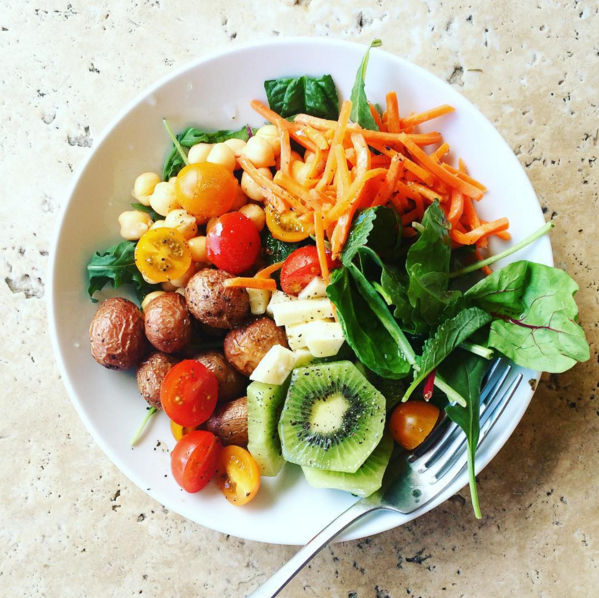 {salad with roasted baby potatoes, chickpeas, kiwi & asiago cheese}
{salad with roasted baby potatoes, chickpeas, kiwi & asiago cheese}
Let’s summarize. With intuitive eating, you actually get to be in control again by allowing yourself to choose when, how much and what you eat. You shift your focus to the internal (listening to your hunger and fullness cues and cravings), rather than listening to external food rules that society sets for you.
In the beginning, it can be difficult to get back in touch with subtle hunger and fullness cues. A helpful tool I use with my clients is the hunger and fullness scale.
When you sit down for a meal. Ask yourself, where am I on the hunger & fullness scale? Ideally you’d be just below a 4. Halfway through your meal, pause for 3 seconds to check in with yourself and ask, where am I now? Eat until you can leave the table feeling between a 6-7.
Now for some real talk. Do I always eat until a 6-7 and stop. NO! I don’t! I experience a 9 fullness every year on Thanksgiving and sometimes food is delicious and I just want more so I eat to an 8 (Hello, burgers & fries. I <3 you.). That just to say that overeating is normal and is nothing to beat yourself up about. Sometimes I just want a cupcake. And wanting that cupcake has nothing to do with being hungry. And that’s okay.
So before you start Whole30/a detox/any drastic weight controlling process, give your body a chance and just start listening to it again. I’d challenge you for the next two days to bring a bit of mindfulness to mealtimes by keeping track of your hunger and fullness before and after meals. Simply make a note in your phone of where you fall on the hunger & fullness scale.
{calzone pizza at Mascalzone. It is just as insanely delish as it looks.}
If you don’t have normal hunger and fullness cues, ask yourself: Do I eat regularly? Or, do I constantly skip meals and snacks even when I’m hungry? If you don’t listen to your body when it tells you it’s hungry (aka disordered eating), it’s pretty easy to jack up your metabolism and stop feeling hunger regularly. To get back in touch with your hunger and fullness cues, I encourage you to work with a dietitian to normalize eating and encourage your metabolism to properly function again.
If you have a difficult relationship with food and your body, I hope you will look into my online course and see if it is something that resonates with you.
I would love to hear your thoughts and opinions on the hunger & fullness scale in the comments section!
 {waffle topped with bananas, nut butter and chocolate}
{waffle topped with bananas, nut butter and chocolate}
Note: If you are suffering from an eating disorder or emotional eating, I encourage you to reach out for help. If you do have an eating disorder, your current relationship with food prevents you from being able to practice intuitive eating. You can not go from having an eating disorder directly to being an intuitive eater.


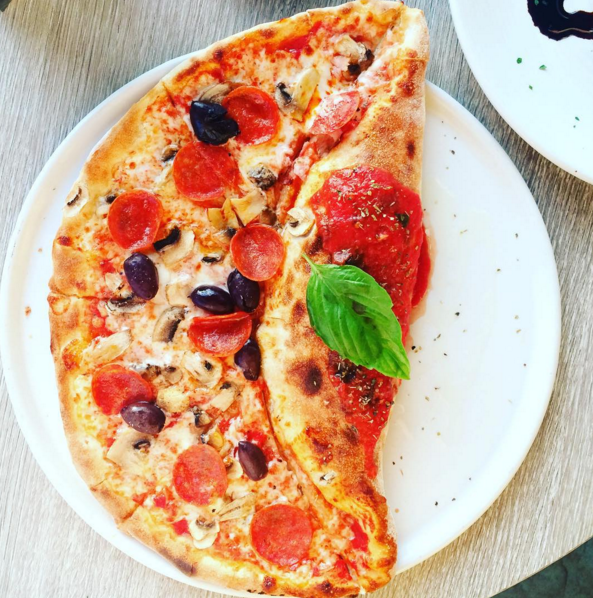
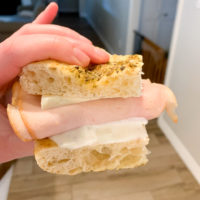
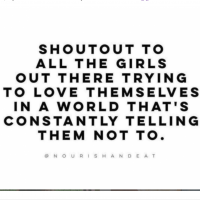
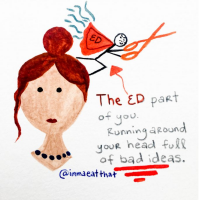

This is something I’ve been trying to do without having a name for it. After the holidays (and requisite overeating), I’m craving fresh and healthful foods. It’s not about dieting as much as the fact that those rich and fatty foods taste better to me when they’re a treat and not a regular habit. As someone who’s had an unhealthy relationship with dieting in the past (and let’s be honest, I’m not sure that ever fully goes away), it’s so nice to come here and read your openness with these issues and solutions for being healthy without making it an obsession. Thank you!
First, I got to say- you are one of my favorite bloggers. It’s hard to find bloggers who preach balance AND showcase it in their own lives.
Second, I really like the hunger scale as a visual! One of my biggest dilemmas with IBS/chronic constipation is not being able to detect my level of fullness. I like to eat, so I usually eat anyways, but I wish I could practice intuitive eating on a deeper level.
I love your new nutrition related topics! And especially your approach to food. Eating everything that your body tells you it wants and eliminating entire food groups!
This is so great! I am becoming better at being an intuitive eating. I try to honor my food cravings when I sit down for a meal. I am learning to trust myself more because, as you mentioned, my body has a weight that it likes to be at. I know that I exercise often and I eat healthy most of the time, so if I want to indulge every so often its okay! I think that is the key to being an intuitive eater-learning to trust yourself. Not everyday is perfect, but I’m getting there.
Thank you for your wonderful posts on this topic! :)
This is awesome, Kylie. As someone who struggled with an eating disorder, this definitely means a lot to me. It was not easy (and it’s still not always easy) settling into intuitive eating, but I think the main lesson I’ve learned is to not beat yourself up if you do go over 7 on the hunger/fullness scale or if you are tempted to stay under 5. It’s just an indication to check in on what else is going on that makes you want to deviate from a healthy fullness. And then you can try again. And then you keep trying until it becomes a habit to stay between 6-7, but you still allow yourself to go above/below sometimes just because of circumstances, celebration, etc.
Thank you for this post!
Great great great point, Alison. I wanted to include something on this but forgot. I’ve updated the post<3 THANK YOU<3<3<3
Hi Kylie,
Thanks for publishing a hunger and fullness scale – I will definitely be referring back to it. I am curious, though, what your take is on food addiction?
Thank you for all of the great posts!
Hi Lesley, glad you enjoyed the post! While there is always exceptions…if someone thought they had a food addiction, I’d encourage them to seek counseling from a therapist who specializes in eating disorders. Typically food isn’t the problem. A lack of healthy coping mechanisms to deal with emotions is the problem. Food issues are very complicated and can be influenced by trauma/pressure from society to look a certain way/stress the individual has been through. The help of a therapist is key. That said, there have been studies done that have shown how soothing sugar is to the brain during times of stress. But using any food to handle stress isn’t a food addiction problem, it’s an emotional problem. Hope that helps!
LOVE LOVE LOVE. <3 Also, I need to read this book! Love that it is written by an expert on eating (a dietitian).
This means the world to read, and I’m really ready to make it a bigger focus in my own life. As a CrossFitter, there is this pressure (I think) to have everything down to a science…meaning doing zone, tracking macros, following ETP or WAG. I’ve tried them, even with a disordered eating past and stop after a few months. It never ends up working well for me because I just want to eat the damn food. So thank you. And I really hope you’ll continue to share this with us.
This is wonderful. Simple and yet exceptionally helpful. Just having you say “Ideally you’d be just below a 4….Eat until you can leave the table feeling between a 6-7” has given me a sense of “normalcy” I was needing to hear. I am struggling to get my hunger cues back, as after a disordered past, my metabolism is still very off. So although I am aware I may not be able to shoot for or practice intuitive eating as it is meant to be (yet), this still gives me a reminder to what hunger and fullness levels are normal and expected. Thank you so much.
I love Dr Jenn Mann. She has been talking about using a hunger scale for years. Sounds like a good way to get in sync with your body. http://www.doctorjenn.com/dr-jenn-store/no-more-diets-app/
I love that there’s difference indicated between “physically full” and “satisfied”. These are totally different feelings and I don’t think it’s always made clear that there is a distinction. There are plenty of times where I feel “full” or “full-ish” but still hungry. Excellent post!
I was just at Common Bond today for lunch! Love that place. :-)
Also love your blog!
This is amazing I love the hunger and fullness scale you use, I find that so many of them are based around trying to get people to eat less. Thanks so much for sharing this!
This was something that we had to do at every single meal while I was in residential treatment for an eating disorder. Unfortunately, since my hunger cues had disappeared, and due to all of the fun of refeeding, taking this practice seriously was slightly lost. Every meal began with a solid ‘5 – I am neutral, not hungry, and indifferent,’ and every meal ended with a ’10 – I have never been so full in my life what are you guys doing to me.’
Six months residential, and through working with an out patient treatment team, I am able to appreciate this scale more. Like you disclaimer noted, I am in no way ready to complete intuitive eating. But just knowing that it is a possibility, that there is a future life out there that doesn’t include food rules, calculations, planning, etc. is really helpful for me. In treatment, we always had to clear our pre-portioned plates that were set out for us. It didn’t matter if halfway through we got full, we had to finish. It didn’t matter if we were still hungry after, we didn’t get more. While at the time, yes, this is what my body and my eating disorder needed, post-treatment it made it hard for me to do anything different. Today, I still feel as though I have to finish everything on my plate, even if I feel physically full and I know that I met all of the exchanges in my meal plan. If I leave anything leftover, I am terrified that those around me will assume that it was my eating disorder’s choice to do so, and not mine. If I am still hungry after a meal, it is incredibly difficult to honor that and get something extra or go back to seconds.
While these are all things that I am working on with my dietitian, seeing this post from a source outside my treatment team / residential really validated the work that I have been doing in moving towards more intuitive eating.
When you say your hunger cues had disappeared, does this mean you could not tell when you were hungry? Or does it mean you could not tell when you were full? I am having a very difficult time with this. I experience extreme hunger (physical, not emotional) and it comes with quite painful stomach cramps-forget that rumbling stomach stuff-headaches, & nausea, among other symptoms. It is extremely difficult to get to a place of feeling full/satiated/satisfied when I experience this extreme hunger. I have found the physical symptoms this causes to be so painful/uncomfortable that even after I get to a point of not being hungry, later that day I will want to eat EVERYTHING. I am seeing a pattern of the tendency to binge occur the next meal after an episode of extreme hunger. I do not skip meals, but a delay sometimes can result in the extreme hunger. Sometimes I am not particularly hungry when I begin a meal, but sometimes increasing intense hunger occurs after I have begun eating. All this is very confusing. The best I have been able to do is be proactive in trying to prevent extreme hunger episodes by eating regularly & on time & making sure I drink 24 oz of water between meals. I am wondering if there is a way to fix these distorted hunger signals, so I was interested in your experience of disappearing hunger cues.
Wow, I agree with every single thing from this post. Just what I needed to hear/read as I recovered from an eating disorder not long ago. Thanks for encouraging eating normal food, without any guilt :)
YES YES YES!! I love this! I’m all about intuitive eating! I completely agree with this and believe that it’s SO much more important to listen to your body than some diet book that knows nothing about you! :) Great post my friend!!
Pingback: Bean Bytes 173
Pingback: Orange Chili Vinaigrette - 24 Carrot Life
Pingback: You have two kinds of hunger. – Yeah…Immaeatthat
Pingback: If You Can’t Stick To A Diet, Your Body Is Telling You To Chill Out – Elite Daily | Globall News
Pingback: The Care & Keeping of Meals – The Newlywed: D.C. Edition
Just re-read this post to help myself stop feeling like I’m “out of control” with my food since I’ve been more loose and following intuitive eating.
Question though- sometimes I eat as much as I feel necessary but then continue to be hungry (less than) an hour or two later. This happens quite frequently and then I feel like I’m always eating. What starts out as genuine hunger turns to a binge (because after the third Time in the kitchen, I begin to stop caring and just start eating. ) how do I know i am eating enough to sustain myself without undereating and then feeling ravenous (leading to a binge?) (ps just as some background I am a person who usually overeats and binges vs undeating and skipping meals)
Pingback: Training Talk: What Female Athletes Need to Know About Fueling Their Bodies | Sanford POWER: Sports & Athletic Training
Pingback: Mindful Eating (…don’t water it down to “just eat slow without distractions”) – Yeah…Immaeatthat
Pingback: My path to becoming an eating disorder dietitian. – Yeah…Immaeatthat
Pingback: Are you even hungry? (How to tell, with 4 strategies) | WhyFoodWorks
This post is so helpful! I was just wondering if you’re looking at the fullness scale directly after you finish a meal, or are you supposed to wait the traditional 20 minutes or so to let your body recognize its fullness? Otherwise, if you ate to a 6-7 (and then your body caught up 20 minutes later) you might feel uncomfortable? Thank you in advance!
Hi Nikki, I would recommend just being curious. If you eat to a 6-7 and then end up uncomfortable 20 minutes later I’d encourage you to think about when you would want to stop eating next time to feel better.
I’ve never actually looked to see if there is evidence behind the “wait 20 minutes” recommendation. That advice has never really seemed helpful to me because it seems like a rule you HAVE to follow, instead of tuning into my body’s own wisdom of hunger and fullness.
Do you think it’s possible the some days I literally eat AT LEAST Double the amount of my usual intake…without literally going over a 7. I’m flabbergasted at my body sometimes. I also am a professional fitness competitor and try to be more intuitive less rigid in my “offseasons”
I believe it! We aren’t robots who need the same amount of food everyday. Each day can be drastically different!
Long time reader, first time commenter. Reading and rereading your incredibly informative, light hearted and kind posts during my lunch break. I just wanted to let you that reading your amazing blog empowers me to be the best me. I — like you— am trying to let go of the notion that body size is more important than mental health. What if by just eating that freakin muffin and not worrying about it, I was actually making a healthier choice than eating kale and panicking about it. Just some food for thought. If you needed any encouragement that your job and blog are worthwhile and improving the lives of others, here it is.
—Kaylie, Los Angeles
P.S. Your daughter Jojo is nothing short of adorable, and so blessed to have such a loving, kind mama. She’s so lucky to grow up without diet culture! Due on March 3 and I hope my daughter will be as lucky as yours.
Thanks for the thoughtful comment, Kaylie<3
Pingback: Avoiding food fear this holiday season – Lift, Eat, Life
Pingback: Macro Counting - An IIFYM review, A Dietitian's Perspective and Top Lessons Learned - This Unmillennial Life
Pingback: A Little Somethin' Sunday #21 - Sinful Nutrition
Pingback: Are You Listening to Your Hunger and Fullness Cues? - Chelsey Amer
Pingback: My path to becoming an eating disorder dietitian. – immaEATthat
Pingback: You have two kinds of hunger. – immaEATthat